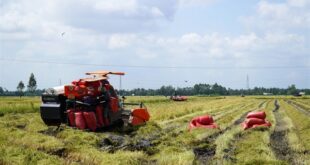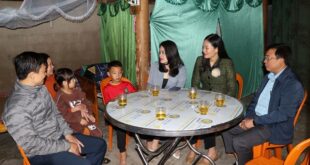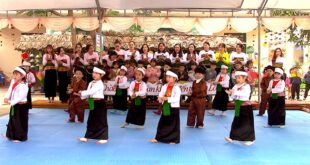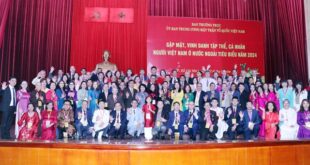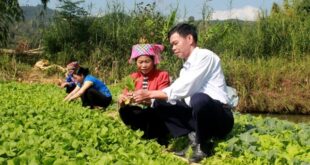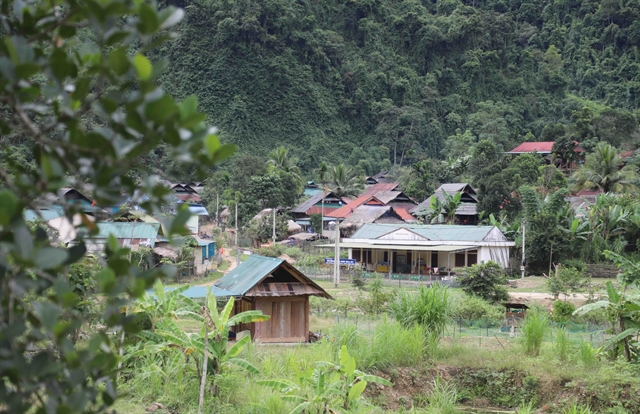 |
| Na Ngân Village in Tương Dương, Nghệ An. More than 20km from the commune centre, the only access to the village is by a steep road running along the slopes of Pù Hiêng Mountain. — VNA/VNS Photos Xuân Tiến |
NGHỆ AN — One of the nine villages in the remote region of the central province of Nghệ An, Na Ngân is the most remote and difficult to reach.
More than 20km from the centre of Nga My Commune (Tương Dương District), people can only reach this isolated village via a steep dirt road running along the slopes of Pù Hiêng Mountain.
Currently, there are over 150 households with more than 750 inhabitants, all of whom are of the Thái ethnic group. Despite being mostly isolated from the outside world, thanks to the attention from authorities and the people’s willpower, Na Ngân Village has been thriving and the economic life of the people is gradually improving.
Rich in ancient Thái ethnic tradition
According to the village elders, since the 1950s, Thái ethnic groups from districts like Con Cuông and Quế Phong have settled in this area, attracted by the perennial flow of the Nậm Ngân River, abundant water, fertile soil and a relatively flat valley. The village name Na Ngân translates from the Thái language as “fields beside the Nậm Ngân river.” Beyond supporting agriculture and fish farming, the river has played a significant role in shaping Na Ngân Village for the Thái people, reflecting the saying “Thái people follow water, Xá people follow fire, Mông people follow mist.”
The uniqueness and attention-catching aspect for tourists are the stilt houses, and roofs made of Pơ mu wood covered with moss. According to local Kha Văn Luận, currently, the village has six stilt houses with roofs made of Pơ mu wood. These stilt houses belong to the group of ancient stilt houses, built first in the village, having existed for decades, going through many generations in the family, the clan, with a unique architecture, bearing the very characteristic cultural identity of the Thái people.
Luận said that the villagers in the village are all Thái ethnic people with a tradition of building stilt houses. The first stilt houses built in the village last up to 70 years. Especially, stilt houses with roofs made of Pơ mu wood still have the original features from when they were built.
According to Luận, people in the village still maintain traditional Thái cooking methods. Especially during festivals such as Tết (Lunar New Year), there will be many dishes that bear the cultural identity of the Thái people such as fish paste, grilled fish, round black sticky rice cake, and square sticky rice cake with flower filling. During festivals, traditional Thái folk dances are organised by the villagers.
 |
| A Thái ethnic woman cleaning rice. |
Efforts to escape poverty
Along with Na Ca, Canh and Xốp Kho, Na Ngân is one of the four villages in poverty in Nga My Commune. Isolated from the outside region, with difficult and arduous transportation, Na Ngân’s citizens mainly depend on small-scale agriculture, and small-scale livestock and poultry farming.
Though the proportion of poor and near-poor households is still high, in recent years, the people in the village have built self-reliant economic models, and step by step escaped poverty.
A remarkable change in Na Ngân Village today is the presence of two schools, a kindergarten, and an elementary school, right in the centre of the village, creating favourable conditions and ensuring that 100 per cent of students in the village are educated. In 2016, electricity came to Na Ngân for the first time, creating a significant turning point in the transformation of the village, ending the situation where people had to use oil lamps, generator sets, and water-powered turbine-generators.
A remarkable achievement to mention in Na Ngân is the construction of a road connecting the central area of Nga My Commune through difficult villages like Na Ca, Na Canh, Xốp Kho to Na Ngân Village, formed in 2010. Although it is a small, narrow dirt road with steep slopes, deep ravines, slippery and, on rainy days, only suitable for motorcycles, it has shortened the travel time to the village by many times.
Lương Văn Tiến, former head of Na Ngân Village, along with the early-generation teachers who ventured into the village, vividly recall the challenges they faced before the construction of the road. Traveling alongside the Nậm Ngân Stream, they grappled with the task of carrying motorcycles across the stream over 40 times. These journeys were demanding, requiring an early start, and often the villagers wouldn’t reach the village until evening. During the flood season, the difficulties of the journey intensified.
Lương Văn Ớt, current head of Na Ngân Village, notes that considerable progress has been made since then. Today, most households in the village have access to amenities such as TVs and motorcycles, and many possess ploughs for agricultural use. The village boasts three families operating grocery stores, meeting the essential needs of the local residents. Besides engaging in livestock and poultry farming, villagers leverage the resources from the Nậm Ngân Stream to cultivate fish like carp and tilapia. Expanding grass cultivation areas and banana plantations ensures a stable source of food for livestock.
Additionally, villagers utilise the land along the Nậm Ngân Stream to cultivate various crops, including cassava and corn. During certain seasons, they venture into the forest to harvest bamboo shoots and honey, which are sold in the market to supplement their income.
The primary aspiration of the Na Ngân villagers is the expansion and improvement of the dirt road that connects the central area of Nga My Commune to Na Ngân Village. This development would include the construction of solid bridges over sections where the Nậm Ngân Stream intersects the road, facilitating smoother travel for the residents. Such infrastructure improvements are pivotal to boosting trade, enhancing economic activities and breaking away from the village’s traditional self-sufficiency approach. Furthermore, the villagers call for surveys and initiatives from the Party committee and higher-level authorities to foster suitable economic models for the region. — VNS
- Reduce Hair Loss with PURA D’OR Gold Label Shampoo
- Castor Oil Has Made a “Huge” Difference With Hair and Brow Growth
- Excessive hair loss in men: Signs of illness that cannot be subjective
- Dịch Vụ SEO Website ở Los Angeles, CA: đưa trang web doanh nghiệp bạn lên top Google
- Nails Salon Sierra Madre
 VnExpress News The News Gateway of Vietnam
VnExpress News The News Gateway of Vietnam
